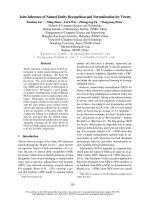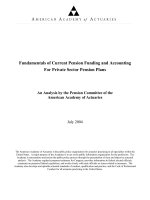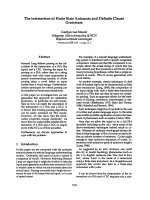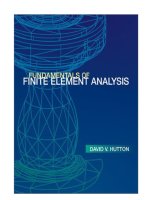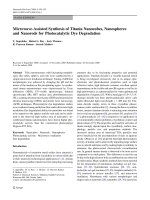Mathematical modelization of electro, machanical coupling problems , application of finite element method and experiment for piezoelectric material
Bạn đang xem bản rút gọn của tài liệu. Xem và tải ngay bản đầy đủ của tài liệu tại đây (3.66 MB, 177 trang )
2
CONTENTS
Introduction 8
Chapter 1 : Preliminary of piezoelectricity 18
1.1 Piezoelectric effect 18
1.2 Unidimensional piezoelectricity 18
1.3 Ferroelectric ceramics 20
1.4 PZT piezoelectric ceramic 21
1.5 PVDF piezoelectric polymers 22
Chapter 2 : Mathematical modeling and numerical method 24
2.1 Mathematical Modeling of Piezoelectricity 24
2.1.1 Static electromagnetism 24
2.1.2 Elements of mechanicals 27
2.1.3 The piezoelectric constitutive equations 28
2.1.4 Differential equations (strong form) and weak form 28
2.2 Finite element method 31
2.2.1 Discretization by finite elements 31
2.2.2 An error estimation of FEM 32
2.2.3 Matrix form of the weak form by FEM 33
2.3 Smoothed finite element method for 2D piezoelectricity 35
2.3.1 A smoothing operator on mechanical strains and electric field 36
2.3.2 Smoothed stiffness matrices for piezoelectricity problems 38
Chapter 3 : Numerical results 42
3.1 The traveling wave ultrasonic motor 43
3.2 Bimorph beam of PVDF 57
3
3.3 Cylinder of PZT 60
3.4 PZT amplifier 67
3.5 Patch test for plane elements 71
3.6 Singer-player piezoelectric strip 74
3.7 Cook’s membrane 78
3.8 MEMS device 80
Chapter 4 : Experiments of piezoelectricity 84
4.1 Measuring equipments 84
4.2 PVDF bimorph beam Experiment 88
4.2.1 Prototyping of PVDF bimorph 88
4.2.2 Measure of PVDF bimorph 89
4.2.3 Remarks on experimental results of PVDF bimorph 93
4.3 PZT amplifier Experiment 94
4.3.1 Prototyping of amplifier 94
4.3.2 Measure of PZT amplifier 96
4.3.3 Remarks on Experimental Results 98
Chapter 5 : Conclusions 100
Publications and accomplishments of thesis 103
References 104
Appendix 116
4
List of symbols and units
for electromechanical quantities
Notation Quantity SI unit Note
,
i
B
B
tensor, matrix magnetic flux
density
Vs/m
2
volt-second per
square meter
E
c
elastic coefficients when the
electric field is kept constant
,
i
D
D
tensor, matrix of electric
displacement field
C/m
2
coulombs per
square meter
,
i
E
E
tensor, matrix of electric
field
N/C newtons per
coulomb
e
coupled constant-coefficient C/m
2
coulombs per
square metre
,
V V
i
f
f
vector of volume force N/m
3
Newton per
cubic metre
,
S S
i
f
f
vector of surface force N/m
2
newtons per
square metre
f
P
vector of point force N newtons
5
,
i
H
H
tensor, matrix magnetic
field
A/m ampere per
meter
,
i
J
J
density of electric current A/m
2
ampere per
meter
,
i
P
P
tensor, matrix of electric
polarisation
C/m
2
coulombs per
square metre
q
S
electric surface charge C/m
2
coulombs per
square metre
q
P
point charge C coulomb
,
ij
S
S
tensor, matrix of strain
t time s second
,
ij
T
T
stress N/m
2
newtons per
square metre
,
i
u
u
vector of displacement m meter
U
density of internal energy
i
x
the cartesian coordinates
6
electric scalar potential V volt
permittivity of the dielectric F/m farads per meter
0
permittivity of vacuum F/m farads per meter
S
permittivity when strain is
kept constant
F/m farads per meter
e
free charge density C/m
3
coulombs per
cubic metre
density of surface charge C/m
2
coulombs per
square meter
v
Mass of volume m
3
cubic metre
i jk
the permulation tensor
7
List of abbreviations
Notation Signification
FE Finite element
FEM
Finite element method
SFEM
Smoothing finite element method
ES-FEM
edge–based smoothed finite element method
PZT
Lead Zirconate titanate (PbZr
y
Ti
1-y
O
3
)
PVDF
Polyvinylidene Fluoride (-CH
2
-CF
2
-)
n
MEMs MicroElectroMechanical systems
T3 Triangle element in FEM
Q4 Quadrilateral element in FEM
ES-T3 Triangle element in ES-FEM
PCM Meshless point collocation method
DCSELAB
National key lab of digital control & system engineering
Introduction
8
Introduction
General description of the problem
The phenomena of transforming directly the different forms of energy of
intelligent materials leads to many impressive and interesting applications. This has
opened many new directions of research which have a great potential in the future.
This also helps to create high increased values for the products. Therefore,
researches and applications of intelligent materials are currently the hot topics.
These materials exist in many forms such as: piezoelectric materials, shape memory
alloys , photoelastic materials, electrostrictive materials and relate to many type of
energy convertions. In particular, the domain of electromechanical energy
conversion lives a strong growing in recently relating mainly to the progress of
piezoelectric materials.
The piezoelectric materials form a complex system, which utilizes two
physical phenomena, that is an interaction between an electric field and a field of
mechanical displacement. It results in two effects. The first one, called direct
piezoelectric effect, corresponds with the appearance of an electric tension when a
mechanical force is applied: the material then plays the role of a piezoelectric
sensor. Conversely, the reverse piezoelectric effect corresponds to the dilation or the
contraction of piezoelectric material when one applies an electric tension to it. The
material then behaves like a piezoelectric actuator. The comprehensive study of
these phenomena, generally coupled between them, is a difficult task but necessary
because of its vast technological applications.
Subjected to electric fields, these materials are capable to produce high
forces in a reduced volumes. Inversely, subjected to external forces conducting to
Introduction
9
displacement and stress fields, the piezoelectric structure produces an elastic field.
Due to this special property, the piezoelectric material has an important role and has
been applied widely in many fields of advanced technology such as: ultrasound
technology, traveling wave ultrasonic motors, nano-positioning systems,
microcontroller systems [25], actuators [9][12], sensors, biochip [13]
From a mathematic point of view, the piezoelectric domain is governed by
the Maxwell’s equations [73] in the material and the general equation of the
elasticity. The coupling between two equilibrium of forces on the surface of
interaction. At low frequencies (up to hundreds of KHz) analytical solutions of this
type of problems exits only for certain simple configurations. For problems where
geometry is complex, we must use methods of discretisation of fields, in particular
the finite element method (FEM).
The researchs in this area
Nowadays, there are seldom research projects about this material in Vietnam.
While the inevitable exploitation of the piezoelectric materials boosts the study on
piezolectric phenomenon in worldwide. The most popular are piezoelectric
ceramics (PZT) and piezopolymers (PVDF). It is used for a large number of
applications. Almost the research reports and applications of the piezoelectric
material have been derived from the long-term and large-scale research projects
with the cooperation of many leading experts and Ph. D students, and these research
reports have been considered as the technological secrets. The research of
piezolectric field relating to a wide range of many sciences. In scope of thesis, we
only mention the development in mathematical modeling, numerical methods and
experiment of some well known groups such as:
-Tzou, H.S. Dept. of Mech. Eng., Kentucky Univ. Robotics and Automation
Proceedings, 1989 IEEE International Conference. In which the development of a
light-weight robot end-effector using polymeric piezoelectric bimorph. The
Introduction
10
development of a lightweight piezoelectric end-effector (multifinger type) for
robotic applications is reported. The fundamental configuration of each finger is a
simple piezoelectric bimorph structure made of a piezoelectric polyvinylidene
fluoride material. Injection of a controlled high voltage into the finger can induce a
deformation in a prescribed direction. Depending on the applied voltage, the
effector can hold an object from outside or inside. The theoretical predictions are
verified by the experimental and finite-element simulation results [97].
-Anderson, E. H., Moore, D. M., Fanson, J. L. & Ealey, M. A., 1990,
‘Development of an active member using piezoelectric and electrostrictive actuation
for control of precision structures’, in which the design and development of a zero
stiction active member containing piezoelectric and electrostrictive actuator motors
is presented. Experimental results are shown which illustrate actuator and device
characteristics relevant to precision control applications [12].
-Ha, S. K., Keilers, C. & Chang, F. K., 1992, ‘Finite element analysis of
composite structures containing distributed piezoceramic sensors and actuators’,
AIAA Journal. A finite element formulation is presented. The formulation was
derived from the variational principle with consideration for energy of the
piezoceramics. An eight-node three-dimensional composite brick element was
implemented for the analysis. Experiments were also conducted to verify the
analysis and the computer simulations [34].
-Hwang, W. S. & Park, H. C., 1993, ‘Finite element modeling of
piezoelectric sensors and actuators’, AIAA Journal, Laminate theory with the
induced strain actuation and Hamilton's principle are used. The equations of motion
and the total charge are discretized. The sensor is distributed, but is also integrated
since the output voltage is dependent on the integrated strain rates over the sensor
area. The actuator induces the control moments at the ends of the actuator [35].
Introduction
11
-Peter L. Levin [76], Finite Element Analysis of a Synthetically Loaded
Stator for a Piezoelectrically Driven Ultrasonic Traveling ware Motor, Worcester
Polytechnic Institute of Massachusetts, USA, 1996. In which, the research build
elements in FEM to simulate traveling ware ultrasonic motor.
-J. A. Christman, R. R. Woolcott, A. I. Kingon, and R. J. Nemanich, 1998,
Piezoelectric measurements with atomic force microscopy, American Institute of
Physics. In which, an atomic force microscope (AFM) is used to measure the
magnitude of the effective longitudinal piezoelectric constant (d33) of thin films.
Measurements are performed with a conducting diamond tip in contact with a top
electrode [39].
-Benjeddou A 2000, Advances in piezoelectric finite element modeling of
adaptive structural elements: a survey, Comput. Struct. Focus is put on the
development of adaptive piezoelectric finite elements [14].
-Sze K Y and Yao L Q 2000, Modelling smart structures with segmented
piezoelectric sensors and actuators, In this paper, a number of finite element models
have been developed for comprehensive modelling of smart structures with
segmented piezoelectric sensing and actuating patches [90].
-Vincent Piefort , Finite Element Modeling of Piezoelectric Active Structure,
Libre University of Bruxelles, 2001 [99]. In which, constitutive equations is
dedicated to the piezoelectricity and simplified for a Mindlin laminate embedding
piezoelectric layers in piezoelectric actuation and sensing devices. The Vincent
Piefort research is implement by the commercial finite element package Samcef
(Samtech s.a.) in FEM.
-Le Dinh Tuan, modelization piezoelectric structures by finite element
method, University of Liege, Belgium, 2002 [46]. In which, the general
thermopiezoelectric constitutive equations are established starting from
Introduction
12
thermodynamics principles. In addition, the Le Dinh Tuan research build elements
in FEM to simulate ultrasonic motor by GetDP/Gmsh software.
-Liu G R, Dai K Y, Lim K M and Gu Y T 2002, A mesh free method called
point interpolation method (PIM) is presented for static and mode-frequency
analysis of two-dimensional piezoelectric structures [50].
-Liu G R, Dai K Y, Lim K M and Gu Y T 2003, A radial point interpolation
method for simulation of two-dimensional piezoelectric structures, Smart Mater.
Struct. A meshfree, radial point interpolation method (RPIM) is presented for the
analysis of piezoelectric structures, in which the fundamental electrostatic equations
governing piezoelectric media are solved numerically without mesh generation [51].
-Andreas Gantner (2005) [13] , which the research presents mathematical
modeling for piezoelectrical agitated surface acoustic waves.
-Chih-Liang Chu and Sheng-Hao Fan, 2006, A novel long-travel
piezoelectric-driven linear nanopositioning stage. Precision Engineering Volume
30, Issue 1, January 2006, Journal of sciencedirect. This study presents a novel
long-travel piezoelectric-driven linear nanopositioning stage capable of operating in
either a stepping mode or in a scanning mode [18].
-Long C S, Loveday P W and Groenwold A A 2006, Planar four node
piezoelectric with drilling degrees of freedom, Int. J. Numer. Methods Eng [55].
-Liu G R, Dai K Y and Nguyen T T 2007, A smoothed finite element method
for mechanics problems, Comput. Mech. In this paper, they incorporate cell-wise
strain smoothing operations into conventional finite elements and propose the
smoothed finite element method (SFEM) for 2D elastic problems [49].
-Kenji Uchino (2009) [45], in which the research presents piezoelectric
material and structure of piezoelectric motors.
Introduction
13
-Liu G R, Nguyen-Thoi T and Lam K Y, 2009, An edge-based smoothed
finite element method (ES-FEM) for static, free and force vibration analyses of
solids, J. Sound Vib. This presents an edge-based smoothed finite element method
(ES-FEM) to significantly improve the accuracy of the finite element method
(FEM) without much changing to the standard FEM settings. The ES-FEM can use
different shape of elements but prefers triangular elements that can be much easily
generated automatically for complicated domains. In the ES-FEM, the system
stiffness matrix is computed using strains smoothed over the smoothing domains
associated with the edges of the triangles [53].
-Alexandre Pages, Majid Hihoud, Frank Claeyssen, Thomas Porchez, Ronan
Le Letty, Cedrat Technologies S.A. 2010. Electrically-Tunable Low-Frequency
Miniature Suspension. In which optical instruments meet in Space, Aircraft or
Military applications in general, or in the space experiment. These requirements
have driven the development of a new type of Amplified Piezo Actuator [10].
The above researchs have contributed greatly to the development of the field
piezoelectricity but there are some unresolved limitations as:
-They skip the study of mathematical model to solve the electromechanical
coupling problems closely.
-Most of the above research present theory and use the commercial software
to simulations without develop the source code. Numerical results of simulations
have not improved because they still use the standard Finite Element Method
(FEM). In addition, a few of which used the meshless methods but it is too complex
and incomplete.
- In the above researchs, edge-based smoothed finite element method (ES-
FEM) is a good improvement of FEM but not yet used for electro-mechanical
coupling problems.
Introduction
14
-The most of above researchs only have focused on numerical simulation,
rarely invest in experiments to compare the data of experiment with the result of
simulation therefore research process is not complete. Otherwise a few of them have
to make mention of experiments with conventional measurements, which an idea
suggest that need to find the non-contact measurements in high-tech.
In this research, we are going to implement a series of studies in order to new
supplement and improvement as: working closely with mathematical modeling,
application innovative FEM, development source code to numerical simulation and
perform experiments to verify the simulation results.
These valuable resources, new ideas to perform and researched expectations
-The idea of the proposal to extend Lax-Milgram theorem [33] with four
bilinear in variational problem and approximating problem, the estimation of error
and convergence rate are new theoritical supplements in mathematical modelization
of electromechanical coupling problems (present in 2.1 and 2.2). Which imply that
the problem becomes more closely. It is new research of thesis.
-About smoothed finite element method (ES-FEM) [30][46][52]: it was
recently proposed by [32] to significantly improve the accuracy and convergence
rate of the standard finite element method for pure mechanical problems (only a
mechanical field). In this thesis, ES-FEM is further extended for the
electromechanical coupling problems with two fields, electric field and field of
mechanical displacement (present in 2.3). It is new ideas of thesis.
-This thesis will develop calculating programs in Matlab for FEM and ES-
FEM [53], that provides a convenient tool to predict behaviour of piezoelectric
structures with 8 numerical examples (present in chapter 3). It is specific point of
the research.
Introduction
15
- In the research, we perform two experiments for piezoelectric materials,
one made of PVDF and the other made of PZT, which prototyping and measuring
systems will be tangible results of the research (are shown in chapter 4). All
experiments are realized on high-tech equipments in Measurement Module,
National key Lab at Digital Control & System Engineering (DCSELAB). The
measurement of non-contact displacement by laser energy and optical microscopy
systems with resolution 10 nanometers are original contributions of the thesis.
Objectives of the research
Generally speaking, this research aims at a mathematical modelization of
electro-mechanical coupling problems, find effective solution to validate the finite
element model and perform the experiments for comparison with simulation. In
detail, the research carried out the principal specifications as follows:
-Mathematical modeling of piezoelectricity in which proposal differential
equations system, variational problem, Lax-Milgram extented theorem,
approximating problem with error estimation and convergence rate (FE in Sobolev).
That make process to solve a electromechanical coupling problem more closely.
-Find effective solution and appropriate method to development of
calculating programs concerns simulation of the piezoelectric structure which
implies that applications of ES-FEM (edge-based smoothed FEM) to solve the
electromechanical coupling problems. It aims to improve the numerical results of
simulation by a new method.
-Perform experiments for two kind of piezoelectric ceramics (PZT) and
piezopolymers (PVDF) in which the non-contact measurements by optical
microscope, laser-energy systems are used and data of experiments in comparison
with result of numerical simulations.
Introduction
16
Structure of the thesis
The work composes of introduction and 5 chapters, the introduction by its
current pages, gives us the general description of the research as well as the
objectives of the thesis. The chapter 1 is devoted to the preliminary of the
piezoelectricity. First of all, describe the piezoelectric effect and details the basic
formula in the case of unidimentional piezoelectricity to show the nature of the
electromechanical coupling phenomena. The next is the behavior of PZT and PVDF
material also considered under electric field.
In chapter 2 concerns with mathematical modeling of piezoelectricity,
standard finite element method (FEM) and smoothed finite element method for
piezoelectric material.
The chapter 3 includes a series of numerical test. The first three examples in
sections 3.1, 3.2, 3.3 are solved by Matlab code of thesis in standard finite element
method (FEM). A more detailed the example 3.1 uses piezoelectric triangular
element in 2D and the results in comparison with result of Peter L. Levin’s paper
[76], the example 3.2 uses piezoelectric plate element in 3D and the results in
comparison with result of experiment in section 4.2 in chapter 4, the example 3.3
uses piezoelectric tetrahedral element in 3D and the results in comparison with
result of COMSOL sotfware. The next is the example 3.4, a problem of PZT
amplifier with complex geometry boundary was simulated by COMSOL sotfware
and the results in comparison with result of experiment in section 4.3 in chapter 4.
The last four examples relate to the benchmarks problems to verify effect of the
ES-FEM, in which the results in comparison with results of papers [24][71][75][92].
They lead to the conclusion that ES-FEM is an effective solution to solve the
electromechanical coupling problems.
In the chapter 4, first of all the test facilities for piezoelectric systems is
briefly introduced. The next is presentation of two experiments. One relating to
Introduction
17
design, fabrication the PVDF bimorph beam and design, assembly the non-contact
displacement measurement by optical microscope system. The other relating to
design, fabrication the PZT amplifier and design, assembly the non-contact
displacement measurement by laser-energy systems.
In chapter 5, conclusions of thesis in which the main originalities of this
research are described and key results are recalled, this chapter also mention to
subsequent research of the thesis to extend the theory, additional technologies
involves a complete fabrication process and commercialization of research
products.
After chapter 5 is the list of publication papers and references. Finally, in
Appendix we present contents of source codes.
The preliminary of piezoelectricity
18
Chapter 1 : Preliminary of piezoelectricity
1.1 Piezoelectric effect
The phenomenon of piezoelectricity is the appearance of a polarization that
already exists in some natural or artificial anisotropic dielectrics, when they are
deformed under the effect of a proper force. If there is a capacitor by depositing a
pair of electrodes on opposite sides of a piezoelectric plate, it appears, under the
influence of a force, charges of opposite signs on opposite plates and potential
proportional to the applied force. Such a device allows measurement of forces at
any physical quantity it could bring pressure, acceleration, vibration, and it is
therefore a piezoelectric sensor.
The piezoelectric effect is reversible: under an electric field of proper
direction, a piezoelectric material deforms and may in particular be excited at its
mechanical resonance, which is very acute. This property finds its application in the
production of genetic operator ultrasound filters and oscillators in the steering.
These properties are here and the piezoelectric materials in which they occur
are called piezoelectric. PZT (PbZr
y
Ti
1-y
O
3
), and PVDF (-CH
2
-CF
2
-)
n
are
commonly used piezoelectric materials [45].
1.2 Unidimensional piezoelectricity
In the following section, we build the unidimentional constitutive equations
base on electrostatics point of view.
The formulations of Gauss's law:
0
D E E P
(1-1)
The preliminary of piezoelectricity
19
0
P E
(1-2)
where
0
is permittivity of the vacuum (
12
0
8.85434 10 /
F m
) and
is
absolute permittivity of the dielectric.
Under a strain vector
S
applied into piezoelectric material induces a
polarization
eS
, it is called the direct piezoelectric effect, from equation (1-2) we
have the total polarization is given by:
0
P E eS
0
P E E eS
D E eS
(1-3)
The Hook's Law is expressed as follow:
T cS
(1-4)
In the inverse piezoelectric effect, a vector of electric field
E
applied in to
structure inducing stresses
eE
, formulation of Hook's Law become:
T cS eE
(1-5)
From equation (1-3) and (1-5) we obtain coupled equations for piezoelectric
materials:
E
T c S eE
S
D eS E
(1-6)
where:
E
c
are elastic coefficients when the electric field is kept constant and
S
is
the permittivity when strain is kept constant and
e
is coupled constant-coefficient of
piezoelectric material, may be determined by experiment.[99]
The preliminary of piezoelectricity
20
1.3 Ferroelectric ceramics
Now, aimed at understanding the piezoelectric material properties [77][78],
we must first consider the behavior of the material on a microscopic scale. Above a
certain temperature that is called temperature curie (
c
), the crystal structure of a
ferroelectric material does have a center of symmetry and therefore has not electric
dipole moment, below this temperature which is non-central symmetric. In here, the
crystal presents a natural electric dipole; it may be reversed and also switched in
certain allowed directions by the application of a high electric field. The uniform
polarization of regions in crystals called ferroelectric domain and the electric
dipoles are aligned in the same direction. There are many domains in a crystal
separated by interfaces called domain walls. A ferroelectric single crystal, when
grown, has multiple ferroelectric domains in each of which the electric dipole is
aligned in a specific allowed direction. As each of the allowed direction has the
same probability to appear, the net electric dipole summed over the whole crystal is
zero. [99] Figure 1-1 [45] shows schematically the domain reorientation in a multi-
domain ferroelectric piezoceramic. The material is initially poled along the negative
direction (1) and an electric field is applied along the positive direction. The crystal
will the increase of the field as the field is opposite in direction to the polarization.
Figure 1-1 Strain with electric fields & polarization reorientation.
The preliminary of piezoelectricity
21
The strain reaches a minimum at a certain field (coercive field E
c
), where the
polarization starts to reverse in each grain (2). Above E
c
, the crystal expands until
E
max
(3) as the field has now the same direction as the polarization. Near E
max
, all
the reversible polarization has been reversed. As the field is reduced, the strain
decreases monotonically as no polarization reversal occurs. The situation of a zero
electric field (4) is similar to the starting situation expect that polarization is
reversed; the material is now poled along the positive direction.
1.4 PZT piezoelectric ceramic
The PZT material is excellent piezoelectric performance under a high DC
field as good as the state of remanent polarization. Figure 1-2 [99] shows a typical
electric field and strain curves (directions x
3
and x
1
, parallel and perpendicular to
the field) for a PZT based ferroelectric piezoceramic [98]. In a cycle with a small
maximum electric field, the field-induced strain curve is almost linear (a). The
curve becomes distorted as the electrical field increases and shows a larger
hysteresis (b, c, d) and finally transforms into a symmetric butterfly-shape when the
electric field exceeds the coercive field; this is caused by the polarization due to
dipole reorientation.
Figure 1-2 Electric field / strains of PZT.
The preliminary of piezoelectricity
22
Under chemical point of view, the Lead Zirconate titanate (PZT) is a binary
solid solution of PbZrO
3
and PbTiO
3
. The PZT (PbZr
y
Ti
1-y
O
3
) is composed of a
lattice of basic cells having the structure Figure 1-3. The electric properties of
ferroelectric ceramics can be modified by substituting ions of different valence in
the lattice.
Figure 1-3 PZT structure
1.5 PVDF piezoelectric polymers
In many technical cases, one need a kind of piezoelectric materials is more
flexible than PZT (it were known crispy materials). Professor Kawai discovered the
piezoelectricity in polyvinylidene (PVDF) in the form of sheets shown as Figure
1-4.
Figure 1-4 Chemical structure of polyvinylidene Fluoride.
The PVDF material is a thin plastic polymer sheets, it is flexible and shows
large compliance. This feature makes is suitable for applications. The performance
The preliminary of piezoelectricity
23
of these materials greatly depends on the thermal and poling conditions. A thin
PVDF film was extended and poled at 100
0
C under a high electric field such as
300- kVcm
-1
[37]. PVDF is a polymer, (-CH
2
-CF
2
-)
n
, which has crytallinity of 40 to
50 percent.
There are two kind of PVDF form can be obtained, uni-axial and bi-axial,
when applying high electric field by one or two perpendicular directions prior to
polarization process shown as Figure 1-5 [99].
Figure 1-5 Uni-axial and Bi-axial film.
Numerical method for piezoelectric material
24
Chapter 2 : Mathematical modeling and
numerical method
2.1 Mathematical Modeling of Piezoelectricity
Piezoelectricity results from the interaction between electric field and
mechanical displacement field. It is presented in two forms. The first rises to an
electric tension when one applies a mechanical stress to the substrate; it is called
the piezoelectric direct effect: the material then plays the role of a piezoelectric
sensor. Conversely, the piezoelectric inverse effect corresponds to the dilation of
piezoelectric material when one applies an electric field to it. The material then
plays the role of a piezoelectric actuator. From a mathematical point of view, the
piezoelectric field is governed by the Maxwell's equations in the material and the
general equations of elasticity.
In this section, mathematical modeling of piezoelectricity is perform, which
author formulated the variational problem and proved the unique existence of
solution and unique solution depends continuously and stably on the mechanical
loads and electric field in the standard Sobolev spaces [80].
2.1.1 Static electromagnetism
The framework of piezoelectricity places us in the field of static
electromagnetism [61] where all the charges are fixed in a permanent way in
space; if they are moving, they move like a DC current in a circuit (so that the
volumetric density of free electric charge,
e
is constant). In this case, the electric
displacement
i
D
and the magnetic induction
i
B
are constant and the Maxwell's
equations [73] become then:
Numerical method for piezoelectric material
25
k i
i jk
j
i
e
i
E B
t
D
x
(2-1)
where
ijk
is the permulation tensor and
i
x
(i=1,2,3) are the cartesian
coordinates.
The electricity and magnetism are distinct phenomena as a long time as the
charges and the currents are static. the relationship between the electric
displacement (
i
D
), electric field (
i
E
) and polarization (
i
P
) from Faraday’s
experiment in [99]:
0
i i i
D E P
and
0
i i
P E
We have new equation :
i i
D E
(2-2)
where
is the electric permittivity.
- Electrostatics
From a practical point of view, the magnetic phenomena are not taken into
account when piezoelectric mediums are considered: those are negligible in front
of the electric phenomena. Consequently only the electrostatic laws come into
play, namely:
0
k
i jk
j
E
x
(2-3)
i
e
i
D
x
(2-4)
- Approach in potential scalar electric
The equation (2-3) expresses that the electric field [61] is irrotational and
permits to introduce the electric scalar potential quantity such as


